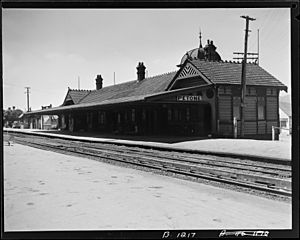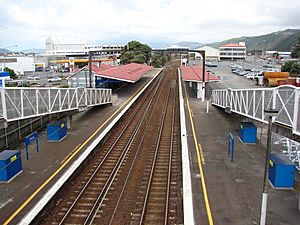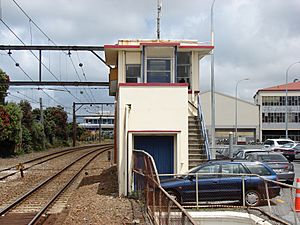Petone railway station facts for kids
Quick facts for kids
Petone
|
||||||||||||||||||||
|---|---|---|---|---|---|---|---|---|---|---|---|---|---|---|---|---|---|---|---|---|
| Metlink suburban rail | ||||||||||||||||||||

Platform one and Ticket Office/Waiting Room
|
||||||||||||||||||||
| Location | Hutt Road, Petone, Lower Hutt, New Zealand | |||||||||||||||||||
| Coordinates | 41°13′19.91″S 174°52′9.89″E / 41.2221972°S 174.8694139°E | |||||||||||||||||||
| Owned by | Greater Wellington Regional Council | |||||||||||||||||||
| Line(s) | Wairarapa Line Melling Branch |
|||||||||||||||||||
| Platforms | Dual side platforms (Formerly side and island) | |||||||||||||||||||
| Tracks | Mainline (2) | |||||||||||||||||||
| Connections | Bus services | |||||||||||||||||||
| Construction | ||||||||||||||||||||
| Parking | Yes | |||||||||||||||||||
| Bicycle facilities | Yes | |||||||||||||||||||
| Disabled access | Yes | |||||||||||||||||||
| Other information | ||||||||||||||||||||
| Station code | PETO | |||||||||||||||||||
| Fare zone | 4 | |||||||||||||||||||
| History | ||||||||||||||||||||
| Opened | June 1875 | |||||||||||||||||||
| Rebuilt | 2003-2004 | |||||||||||||||||||
| Electrified | 12 September 1953 | |||||||||||||||||||
| Previous names | Korokoro, Petoni | |||||||||||||||||||
| Services | ||||||||||||||||||||
|
||||||||||||||||||||
Petone railway station is a train station with two platforms located in Petone, a suburb of Lower Hutt, New Zealand. It is on the Hutt Valley Line, which is part of the Wairarapa Line. The station is about 10.5 kilometers (6.5 miles) north of Wellington railway station. It is also where the Melling Branch line, which goes to Melling railway station, splits off towards Melling just north of the station.
The station is used by Metlink suburban trains, which are run by Transdev Wellington. These trains go to Wellington, Melling, Taita, Upper Hutt, and Masterton.
Petone station has two side platforms. You can get between them using an underpass to the south or a bridge over the tracks to the north. This bridge also connects to Pito-one Road, across State Highway 2. There's a bus stop where you can catch buses from Maungaraki and Korokoro to connect with trains going to and from Wellington. Other things at the station include two parking lots (called park and ride), a place to buy tickets, a waiting room, and bike storage.
Contents
History of Petone Station
The railway line that runs through Petone was first opened between Wellington and Western Hutt (which was then called Lower Hutt) on 14 April 1874. Even though the line passed through the area, a station in Petone didn't open until the next year.
The First Petone Station
In June 1875, a small station called a "flag station" was opened near the Korokoro Stream. This was just north of where the station's footbridge is today. It was named Koro-Koro, which was the name of the area at that time.
The Second Petone Station
Around 1879, the station was moved to a new spot, closer to where people lived. However, it was hard for people to get to this new station. Because of this, most people living in the area signed a petition asking for the station to be moved back.
The old station building from the first site was later moved and used as a police lock-up (a temporary jail) for many years. It stayed there until 1964, when it was destroyed along with other buildings nearby.
The Third Petone Station
On 27 July 1905, a brand new station was opened at a new location. This building was designed by George Troup, a famous architect. This happened when a new double railway line was opened between Petone Junction and Lower Hutt. This new line went past the Petone Workshops on the east side, while the old main line used to be on the west side. The work to add a second track from Lower Hutt and Petone to Wellington started in 1903 and was finished in different stages between 1905 and 1911.
Modern Upgrades at Petone
In 2000, people started looking into making the station better. This was because the Wellington Regional Land Transport Strategy said the station needed upgrades by 2004.
The next year, different ideas for the station were looked at, and people living nearby were asked for their thoughts. One important part of the new design was to include a bus stop area. This was planned because new bus routes were going to start in October 2003.
In 2003, the Hutt City Council agreed to own the station for legal reasons. Four companies offered to do the building work. Construction started in June 2003. Later that year, it was decided that the Greater Wellington Regional Council would own the station once the work was finished.
The improved station officially opened on 3 March 2004. It included many new features:
- New ways for buses to get to the station.
- An upgraded roof over the platforms.
- A covered area for bus passengers.
- A newly paved eastern platform.
- Screens to protect people from wind at the southern end of the platform.
- More seating on the platforms.
- Lights on the ground for the restored historic flagpole.
In the late 2000s, Transit New Zealand worked on a big project called the "State Highway 2 Dowse to Petone Upgrade." This project changed some things at the station. The car park was made bigger towards the south. A new bridge for cars, called Mackenzie Avenue, was built for people using the car park. The entrance to the car park for cars coming from State Highway 2 (going south) stayed the same. Mackenzie Avenue connects to Pito-One Road in Korokoro. From there, drivers can go north onto State Highway 2 or get to Hutt Road using the new Korokoro overbridge. This project also improved the bridge that links the station to the western side of State Highway 2 for people walking.
Both platforms were upgraded in 2009 with new fronts, lights, and paving. This was part of a plan to get ready for the new Matangi trains. Platform 1 reopened for trains going south on 7 December 2009. The whole platform upgrade project was expected to be finished by Christmas 2009.
A new underpass for people walking and cycling, connecting to the Petone to Wellington cycleway, is planned to be built in 2020 or 2021.
Petone Signal Box
Petone used to have one of the last standalone signal boxes in New Zealand. A signal box is a building where people control the railway signals and points (switches) to guide trains safely. The signal box at Petone was built in 1952 and used electricity to control the signals. It replaced an older signal box from 1905.
This signal box controlled the Melling Branch line and where it joined the main line, just north of the station. It was usually staffed only when Melling Line trains were running, which was from 6:00 AM to 7:00 PM, Monday to Friday. Sometimes, it was staffed in the evenings or on weekends if a part of the track past the station was closed. In these cases, the staff would use the signal box to switch trains for their return journey. When the Melling Line was closed, the signal box was turned off, and the signals became automatic.
In late 2013, work began to close the signal box and move the control of Petone and Melling branch signals to a central control center in Wellington. The Petone signal box closed on 24 December 2013. This allowed the signals to be switched over during the quiet Christmas and New Year period. The new automatic signals started working on 6 January 2014.
Train and Bus Services
Train Services
Tranz Metro, working for the Greater Wellington Regional Council, runs electric suburban trains on the Hutt Valley Line and Melling Line. These trains go between Wellington and Upper Hutt or Melling, passing through Petone. They also run the Wairarapa Connection service, which uses diesel trains, between Wellington and Masterton, also stopping at Petone.
Here's a basic look at the train schedule during the day, outside of busy times:
- 2 trains per hour (tph) on the Hutt Valley Line to Wellington, stopping at all stations.
- 2 trains per hour on the Hutt Valley Line to Upper Hutt, stopping at all stations.
- 1 train per hour on the Melling Line to Wellington, stopping at all stations (weekdays only).
- 1 train per hour on the Melling Line to Melling, stopping at all stations (weekdays only).
- Two Wairarapa Connection services per day to Wellington, which do not stop at every station.
- Two Wairarapa Connection services per day to Masterton, stopping at Waterloo and all stations from Upper Hutt.
During the busy morning rush hour, the schedule is:
- 6 trains per hour on the Hutt Valley Line and Melling Line to Wellington.
- 3 trains per hour stop at all stations.
- 3 trains per hour do not stop at every station.
- 3 trains per hour on the Melling Line to Melling, stopping at all stations.
- 2 trains per hour on the Hutt Valley Line to Upper Hutt, stopping at all stations.
- Three Wairarapa Connection services to Wellington, which do not stop at every station.
Bus Services
Metlink bus routes 81, 83, 84, 110, 130, 150, and 154 all stop at Petone station.
Images for kids









